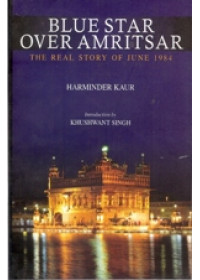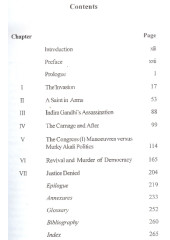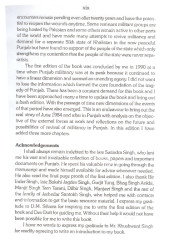Monday to Saturday - 10:00 Am to 9 PM
Now Enjoy Bulk Discounts on Books as Mentioned Below
These Discounts are in addition to the Discounts on Individual Books (Visible as Bulk Discount for Books in Cart)
Extra 10% Off If Books Purchased Exceeds Rs 3000 or 75 USD or 60 GBP or 60 Euro or 100 AUD or 100 CAD
Extra 15% Off If Books Purchased Exceeds Rs 6000 or 150 USD or 120 GBP or 120 Euro or 200 AUD or 200 CAD
Extra 20% Off If Books Purchased Exceeds Rs 15000 or 225 USD or 180 GBP or 180 Euro or 300 AUD or 300 CAD
Extra 25% Off If Books Purchased Exceeds Rs 30000 or 300 USD or 240 GBP or 240 Euro or 400 AUD or 400 CAD
Introduction To 'Blue Star Over Amritsar, The Real Story Of June 1984' By Harminder Kaur
The most monstrous event in the history of independent India was the attack mounted by the Indian army on the Golden Temple at Amritsar in the first week of June, 1984 known by the euphemism "OPERATION BLUE STAR". The Govenment took great pains to misinform the public over the reasons which compelled it to take this action, its unfortunate timing, what actually transpired and the loss of life and property it entailed. Till a few days before the action Prime Minister Mrs. Indira Gandhi and Home Minister P.C. Sethi had been assuring members of both the houses of Parliament that the Government had no intention of ordering the police (and much less the Army) to enter the Temple; at the same time it was evident that the Army had been practising with models of the Temple on how to besiege it.
After the action the entire Government propaganda machine with its All India Radio and Doordarshan network, its handouts followed by a large section of the subservient press flooded the world with a barrage of lies and successfully misled a gullible public into believing that there was no choice left to the Government except to send in the army; that Bhindranwale intended to proclaim an independent state of Khalistan and was in contact with foreign governments which would accord it immediate recognition. Army commanders patted each other for having done a good job in very adverse circumstances with minimal loss of life and damage to the property. All these lies were compiled and published in the form of a White Paper on the Punjab Agitation.
How totally false this official document is can be proved by one fact viz The White Paper on the Punjab Agitation put the number of casualties suffered by the army as under 100. A few days after "Blue Star" Rajiv Gandhi stated in kanpur that the army had lost over 700 men. (He promptly denied having said so). To this day no list of casualties has been published; no explanation given why a large number of dead Sikhs brought for post-mortem had their hands tied behind them and had been shot in head; why it was found necessary to assault the Temple on the martyrdom anniversary of Guru Arjun Dev, the builder of the Temple, where between 10,000 to 20,000 pilgrims were present; why the archives with their priceless collection of manuscripts, handwritten copies of the Granth Sahib and Hukamnammahs bearing signatures of the Gurus were set on fire after resistance had been overcome,
As for the competence of the army, the less said the better. In an age when a handful of Israeli and German commandos could through a well -planned action overcome a well - entrenched enemy thousands of miles away from them, the best our generals could do was to storm the Temple Complex with tanks and armoured cars, blast the Akal Takht to get at Bhindranwale and about 200 of his men. In the crossfire upwards of 5,000 people, a majority of them pilgrims, including women and children lost their lives. Contrary to official contention that no damage was caused to the central shrine, I counted scores of fresh bullet marks on the Harmandir when I visited it a fortnight after the army action. Far from doing a competent job, our army commanders botched up a simple operation. What could have been achieved by a surprise commando raid, a limited siege or by use of gas was instead done in the most ham-handed manner of an untrained butcher.
Even more ironic is the fact that while a foreign government yielded to popular demand for a high-powered non-official enquiry into the Jallianwala Bagh massacre in which 381 lives were lost and published the commission's report censuring General Dyer for excessive zeal, the government of independent India felt no compunction to hold enquiry into "Operation Blue Star" in which it deployed its army to fight their own countrymen and the loss of life was than thirteen times than what it was at Jallianwala Bagh. It is this sort of insensitivity that had persuaded hot-headed young Sikhs to believe that they would get no justice from the government unless they turn to terrorism. This mood of frustration explains the dastardly murder of Mrs. Gandhi and General A.K. Vaidya, former chief of Army Staff and the wicked killings of innocent Hindus. One unpunished crime generates another.
Let it not be understood that I defend Bhindranwale. Far from it, I regarded him as the incarnation of the Devil; a demented rustic who through his hateful utterances against the Hindus brought disgrace on the name of the Sikh Gurus and the Khalsa Panth. It Pained me to see him described as a Sant; it pains me more to see him revered as a martyr. His ghost will continue to disturb the conscience of the Sikhs till they exorcise it from their minds and his baneful influencce from their community's body politic. It is not enough to blame Mrs. Gandhi, Giani Zail Singh and the Congress (I) for having built him up; he became a political monster because a section of the Sikh peasantry responded to his uncouth speeches and his thuggery.
And what about the Akalis? Did they do anything to prevent him from misusing the Temple, converting it into a den for gangsters and making a part of it into a fortress? They did not raise a finger of protest. Most of them were scared of him to death. Others like G.S. Tohra used him as a pawn against his rivals within the party. When the story of the tragic decline in the prestige of the Sikh community after 1982 comes to be written, the name of Gurcharan Singh Tohra will figure only below that of Bhindranwale's as the two principal authors of the downfall of the Khalsa Panth. In Bhindranwale's favour it could at least be said that however wrong he might have been, he was at least a brave fanatic who died like a man. Tohra, on the other hand, despite great show of bravado and much publicised boast that he would die rather than surender, collapsed when the army came to arrest him. He lived on to play politics with the future of his community. One may well ask, what have the Sikhs done to deserve men like Tohra as their guides?
In the absence of reliable data on this horrendous event, we have no choice but to rely on accounts given by eye-witnesses and crosschecking them. Fortunately, there were many who saw the army action and quite a few officers and soldiers involved in it have given their versions. Harminder Kaur has taken great pains in assembling whatever was available and selecting only the credible. She has the gift of a story-teller; she has painted a vivid picture of the fearful violence that occurred in the battle fought between Bhindranwale's band and the Indian army, the sufferings of innocents caught in the cross-fire -many died of thirst - and the vengeance the army wreaked on non-combatants after it had won its pyrrhic victory. This book should not be put in the category of "instant history" because, despite its closeness to the events it describes, it is as objective an account as any published so far. It should find itself on the top of list of books for compulsory reading for anyone who wishes to know the truth about the tragedy of the Punjab.
Preface To 'Blue Star Over Amritsar , The Real Story Of June 1984' By Harminder Kaur
When I wrote the first edition of the book in 1990 I had said: "for most Indians today the Punjab problem began with the emergence of Sant Jarnail Singh Bhindranwale, who wanted to kill the Hindus in Punjab and create the state of Khalistan. Nothing could be more remote from reality. Neither he, nor the political movement of the 1980s nor the majority of Sikhs at any stage demanded Khalistan. Until Operation Blue Star it was the brain-child of a London based politician,Jagjit Singh Chauhan, who made several efforts to rehabilitate himself in Indian politics, even came to India during the rule of the Janata Party but failed dismally every time and returned to the U.K. in 1980 to embark upon this new venture. Even Bhindranwale remained vague whenever asked about Khalistan. He would say: 'I do not ask for Khalistan. But if the government decides to give it this time will not say no.' After Operation Blue Star also the demand for an independent Sikh state was not raised. But after the anti-Sikh riots in November, 1984, this demand was voiced by some to express their anger and anguish.
With the passage of time the demand increasingly became the rallying point of unemployed Sikh youth, fundamentalists and antisocial elements propped up by the militants, the security agencies and the Inter-Services Intelligence of Pakistan.
There was a wide spectrum of reactions. Some agreed with me, some found my contention preposterous. They were natural reactions in the atmosphere of raging passions. But with the passage of time peace has returned to Punjab and we can look back at developments dispassionately and with a greater degree of objectivity. I think I have been proved more than correct. If it had been a popular separatist movement for an independent Sikh state of Khalistan nothing could have contained it. There was no way that the people would have become instrumental in resorting peace in Punjab. The fact of the matter is that the people of the state actively helped the security forces to bring an end to the reign of terror that had destroyed the peace of every home.
Ironically, the demand for Khalistan was a well-orchestrated propaganda unleashed by Mrs. Indira Gandhi and her government and the policy was continued with occasional interruptions by Prime Minister Rajiv Gandhi. The reason for Mrs. Gandhi's political machinations was understandable, through not at all defensible.
Over the years her political base had been shrinking, threatening the hegemony of her party in any future Parliamentary election. She found the intransigent Akalis as the proverbial whipping boys to generate a Hindu backlash.This is apparent from the fact that Mrs. Gandhi backed out on three occasions from a duly negotiated settlement with the agitation Akalis at the last moment. Instead, she ordered the Indian army to storm the holiest of the holy Sikh shrines, the Golden Temple, ostensibly to holy precincts, thereby lacerating the souls of 15 million Sikhs in India and abroad.
This is not to absolve either the Akalis or Sant Jarnail Singh Bhindranwale of their contribution to this catastrophe. Right from the launching of the Dharamyudh under the leadership of Sant Harchand Singh Longowal in August, 1982, the entire Akali leadership of comprising Prakash Singh Badal, Gurcharan Singh Tohra, Surjit Singh Barnala, Balwant Singh, and Ravi Inder Singh did not either give a positive lead to the Sikhs to expose Mrs. Gandhi's machinations or make any effort to help their countrymen to see through her game or muster courage enough to stand up against Sant Bhindranwale and steer the state of Punjab and Sikh Community out of a bloody confrontation. Instead they continued to play politics for their own political survival.
The grievous hurt caused to the Sikh psyche after Operation Blue Star and the indiscriminate killings of the Sikhs after Mrs. Gandhi's assassination in most parts of north india haunted Punjab and the country for many years thereafter. The issues of justice to the victims of the 1984 pogroms against the Sikhs and to the innocents killed in fake encounters remain pending even after twenty years and have the potential to reopen the wounds anytime. Some remnant militant groups are being hosted by Pakistan and some others remain active in other parts of the world and have made many attempts to revive militancy and demand for a separate Sikh state of Khalistan in the now peaceful Punjab but have found no support of the people of the state which only strengthens my contention that the people of the state were never separatists.
The first edition of the book was concluded by me in 1990 at a time when Punjab militancy was at its peak because it continued to have a linear dimension and seemed an unending agony. I did not want to lose the information which formed the core foundation of the tragedy of Punjab. There has been a constant demand for this book and I have been approached many a time new dimensions of the events of that period have also emerged. This is an endeavour to bring out the real story of June 1984 and after in Punjab with analysis on the objective of the external forces at work and reflections on the future and possibilities of revival of militancy in Punjab. In this edition I have added three more chapters.
Table Of Contents For 'Blue Star Over Amritsar, The Real Story Of June 1984' By Harminder Kaur
|
Contents |
||
| Chapter | Page | |
| Introduction | xiii | |
| Preface | xvii | |
| Prologue | 1 | |
| I | The Invasion | 17 |
| II | A Saint in Arms | 53 |
| III | Indira Gandhi's Assassination | 88 |
| IV | The Carnage and After | 99 |
| V | The Congress (I) Manoeuvres versus Murky Akali Politics | 114 |
| VI | Revival and Murder of Democracy | 165 |
| VII | Justice Denied | 204 |
| Epilogue | 219 | |
| Annexures | 233 | |
| Glossary | 252 | |
| Bibliography | 260 | |
| Index | 265 |
| Books | |
| Author | Harminder Kaur |
| Pages | 280 |
| Cover | Paperback |
| Language | English |
Blue Star Over Amritsar - The Real Story Of June 1984 - Book By Harminder Kaur
- Brand: Corporate Vision
- Product Code: SHE114
- Availability: Out Of Stock
-
Rs.395.00
Related Products
I Accuse - The Anti-Sikh Violence Of 1984 - Book By Jarnail Singh
Introduction To 'I Accuse - The Anti-Sikh Violence Of 1984' By Jarnail Singh 'If people have lost..
Rs.250.00
Amritsar - Mrs Indira Gandhi's Last Battle - Book By Mark Tully, Satish Jacob
Introduction To 'Amritsar Mrs Gandhi's Last Battle' By Mark Tully & Satish Jacob On 5th June ..
Rs.295.00
The Punjab Story - Reissued On The 20th Anniversary Of Operation Bluestar - Book By Khushwant Singh
Table Of Contents For 'The Punjab Story - Reissued On The 20th Anniversary Of Operation Bluesta..
Rs.295.00
My Bleeding Punjab - Book By Khushwant Singh
Table of Contents For My Bleeding Punjab - Book By Khushwant Singh Content..
Rs.140.00
1984 Lessons from History - Intrigue and Conflict in Centre - Sikh Relations - Books by Harminder Kaur
Table of Contents For '1984 Lessons from History - Intrigue and Conflict in Centre - Sikh Relatio..
Rs.595.00
Scorched - White Lilies of '84 - Book By Reema Anand
Foreword To 'Scorched White Lilies of '84' By Reema Anand The year 1984 was traumatic i..
Rs.295.00
Operation Blue Star And After - An Eyewitness Account - Book By Brig Onkar S Goraya
Summary of 'Operation Blue Star And After , An Eyewitness Account' By Brig Onkar S Goraya M..
Rs.350.00
Stolen Years
From The Front Cover Of 'Stolen Years' By Pavit Kaur In 1984, Simranjit Singh Mann resigned from ..
Rs.399.00
Tags: books 1984 sikh attrocities, books on 1984 anti sikh riots, books on 1984 sikh massacres, books on history of punjab, books on history of the sikhs, books on operation blue star, books on punjab history, books on sikh history english, books on sikh itihas, books on sikh past, books on sikh rulers, the glorious sikh past over, amritsar, real, june, harminder, kaur, and


















